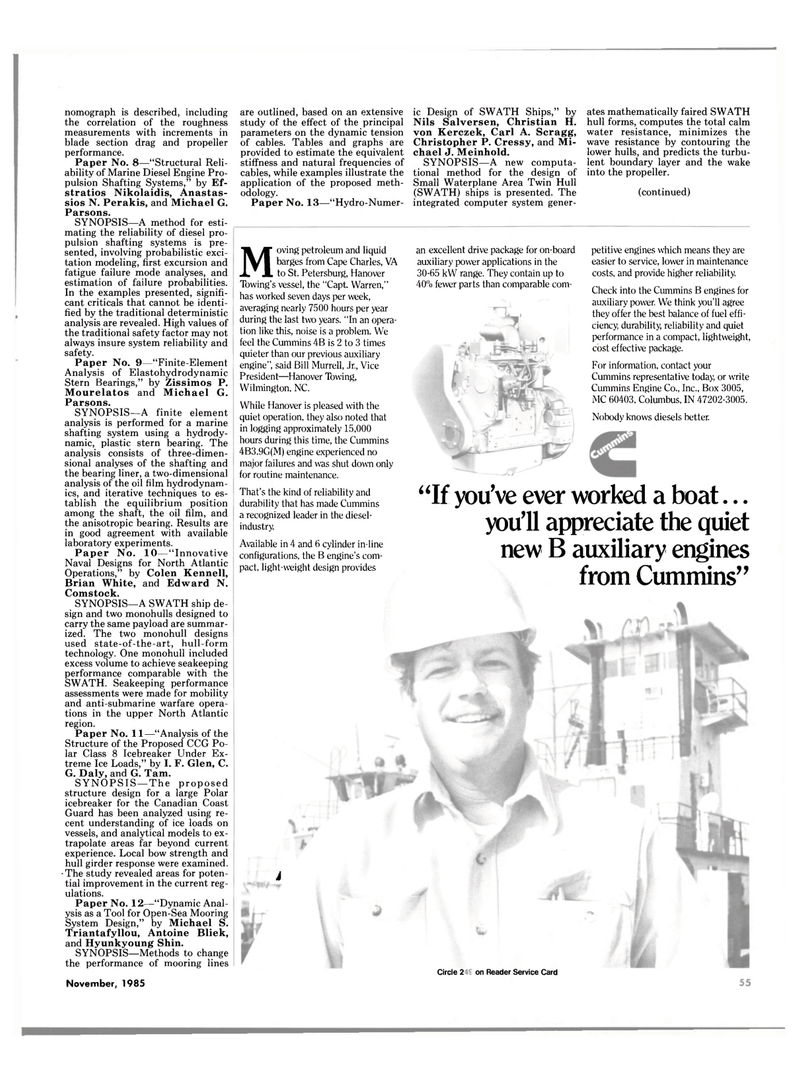
Page 49: of Maritime Reporter Magazine (November 1985)
Read this page in Pdf, Flash or Html5 edition of November 1985 Maritime Reporter Magazine
are outlined, based on an extensive study of the effect of the principal parameters on the dynamic tension of cables. Tables and graphs are provided to estimate the equivalent stiffness and natural frequencies of cables, while examples illustrate the application of the proposed meth- odology.
Paper No. 13—"Hydro-Numer- ic Design of SWATH Ships," by
Nils Salversen, Christian H. von Kerczek, Carl A. Scragg,
Christopher P. Cressy, and Mi- chael J. Meinhold.
SYNOPSIS—A new computa- tional method for the design of
Small Waterplane Area Twin Hull (SWATH) ships is presented. The integrated computer system gener- nomograph is described, including the correlation of the roughness measurements with increments in blade section drag and propeller performance.
Paper No. 8—"Structural Reli- ability of Marine Diesel Engine Pro- pulsion Shafting Systems," by Ef- stratios Nikolaidis, Anastas- sios N. Perakis, and Michael G.
Parsons.
SYNOPSIS—A method for esti- mating the reliability of diesel pro- pulsion shafting systems is pre- sented, involving probabilistic exci- tation modeling, first excursion and fatigue failure mode analyses, and estimation of failure probabilities.
In the examples presented, signifi- cant criticals that cannot be identi- fied by the traditional deterministic analysis are revealed. High values of the traditional safety factor may not always insure system reliability and safety.
Paper No. 9—"Finite-Element
Analysis of Elastohydrodynamic
Stern Bearings," by Zissimos P.
Mourelatos and Michael G.
Parsons.
SYNOPSIS—A finite element analysis is performed for a marine shafting system using a hydrody- namic, plastic stern bearing. The analysis consists of three-dimen- sional analyses of the shafting and the bearing liner, a two-dimensional analysis of the oil film hydrodynam- ics, and iterative techniques to es- tablish the equilibrium position among the shaft, the oil film, and the anisotropic bearing. Results are in good agreement with available laboratory experiments.
Paper No. 10—"Innovative
Naval Designs for North Atlantic
Operations," by Colen Kennell,
Brian White, and Edward N.
Comstock.
SYNOPSIS—A SWATH ship de- sign and two monohulls designed to carry the same payload are summar- ized. The two monohull designs used state-of-the-art, hull-form technology. One monohull included excess volume to achieve seakeeping performance comparable with the
SWATH. Seakeeping performance assessments were made for mobility and anti-submarine warfare opera- tions in the upper North Atlantic region.
Paper No. 11—"Analysis of the
Structure of the Proposed CCG Po- lar Class 8 Icebreaker Under Ex- treme Ice Loads," by I. F. Glen, C.
G. Daly, and G. Tam.
SYNOPSIS —The proposed structure design for a large Polar icebreaker for the Canadian Coast
Guard has been analyzed using re- cent understanding of ice loads on vessels, and analytical models to ex- trapolate areas far beyond current experience. Local bow strength and hull girder response were examined. • The study revealed areas for poten- tial improvement in the current reg- ulations.
Paper No. 12—"Dynamic Anal- ysis as a Tool for Open-Sea Mooring
System Design," by Michael S.
Triantafyllou, Antoine Bliek, and Hyunkyoung Shin.
SYNOPSIS—Methods to change the performance of mooring lines
November, 1985
Moving petroleum and liquid barges from Cape Charles, VA to St. Petersburg, Hanover
Towing's vessel, the "Capt. Warren," has worked seven days per week, averaging nearly 7500 hours per year during the last two years. "In an opera- tion like this, noise is a problem. We feel the Cummins 4B is 2 to 3 times quieter than our previous auxiliary engine", said Bill Murrell, Jr., Vice
President—Hanover Towing,
Wilmington, NC.
While Hanover is pleased with the quiet operation, they also noted that in logging approximately 15,000 hours during this time, the Cummins 4B3.9G(M) engine experienced no major failures and was shut down only for routine maintenance. an excellent drive package for on-board auxiliary power applications in the 30-65 kW range. They contain up to 40"o fewer parts than comparable com- ates mathematically faired SWATH hull forms, computes the total calm water resistance, minimizes the wave resistance by contouring the lower hulls, and predicts the turbu- lent boundary layer and the wake into the propeller. (continued) petitive engines which means they are easier to service, lower in maintenance costs, and provide higher reliability.
Check into the Cummins B engines for auxiliary power. We think you'll agree they offer the best balance of fuel effi- ciency, durability, reliability and quiet performance in a compact, lightweight, cost effective package.
For information, contact your
Cummins representative today, or write
Cummins Engine Co., Inc., Box 3005,
MC 60403. Columbus, IN 47202-3005.
Nobody knows diesels better.
That's the kind of reliability and durability that has made Cummins a recognized leader in the diesel- industry.
Available in 4 and 6 cylinder in-line configurations, the B engine's com- pact, light-weight design provides "If you've ever worked a boat... you'll appreciate the quiet new B auxiliary engines from Cummins" j
Circle 192 on Reader Service Card 1 1 1

 48
48

 50
50
